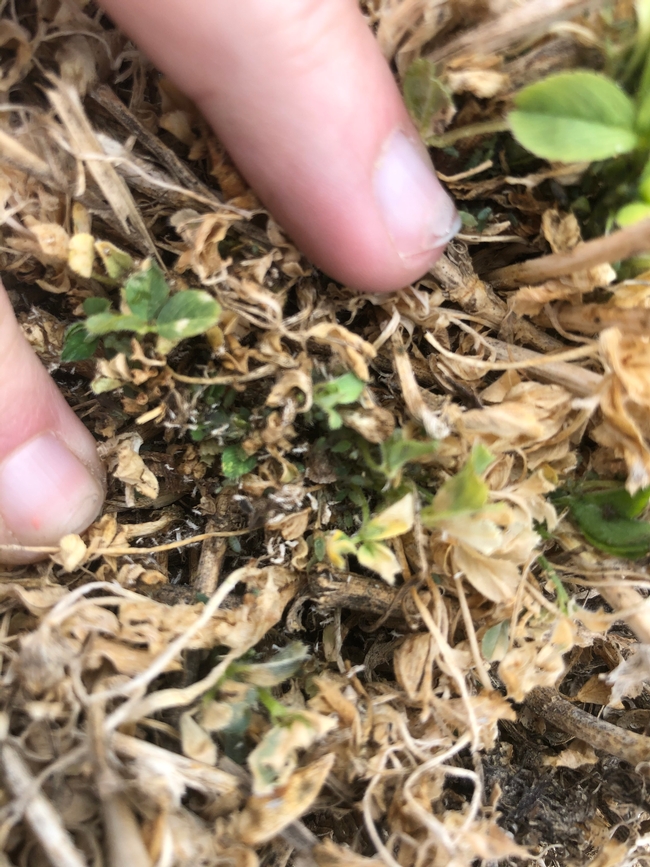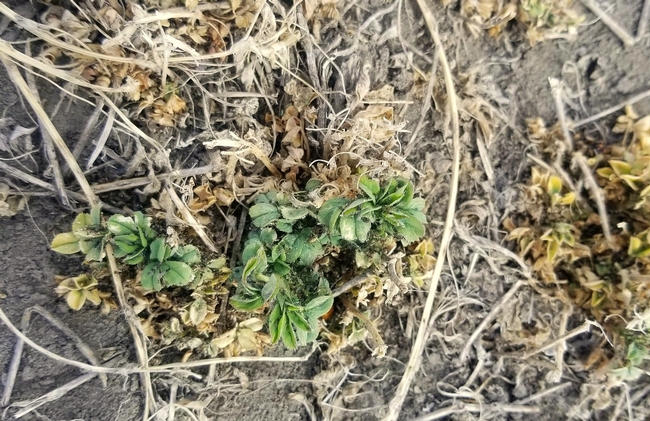Re-posted with permission from the UC ANR Alfalfa & Forage News:
“I'll be back!” And, they are, with a vengeance!
Just like the Terminator, those pesky blue alfalfa aphids are once again wreaking havoc in alfalfa fields, including those just breaking dormancy in colder climates. They are also showing up in the first two cuttings under low-desert conditions in Southern California and Arizona. In some areas, there is a mix of blue alfalfa aphid, pea aphid, and cowpea aphid
How to respond might depend upon where you are, in part due to environment, stage of growth, and role of natural enemies.
Recently, Bill Chounet from Stanislaus Farm Supply contacted us from Nevada, observing alfalfa fields with extensive aphid damage in the very early in the season in Yearington, NV. "“In January I found evidence that an aphid population had been in the crowns of alfalfa earlier (many carcasses); but after digging around and into the crowns, I could not find any live aphids”, he wrote. “In the beginning of March, I began finding aphids in the crowns” (Figures 1,2, and 3).
These aphids were likely feeding in the fall, injecting toxins into the alfalfa as plants were going dormant. Aphid populations clearly took off this spring. Plants were slow to recover (few visible leaves), especially with current aphid infestations and cool daytime temperatures in the upper 20's-40's with occasional 50s-60s.
Ian Grettenberger, Entomologist at UC Davis.
The growers have been struggling with early aphid infestations for several years in this region and growers have tried a number of control approaches. Part of the problem may be the cold temperatures and part of the problem may be the lack of plant tissue and actively growing tissue to assist with systemic insecticide efficacy. In addition, getting good coverage is likely challenging because many of the aphids are tucked into the base of the plant. Furthermore, blue alfalfa aphid is a pest that has been getting harder to control
Figure 1. Damage caused by aphids early in the growth of this Yearington, NV field. (photo: Bill Chounet)
BLUE ALFALFA APHIDS ARE PARTICULARLY PROBLEMATIC
They have toxins!! – Damage, identification and thresholds. Blue alfalfa aphids are particularly damaging to alfalfa because they inject toxins into plants when feeding, causing stunting, reducing yields, and sometimes killing plants. Toxins can remain in the plants after harvest and persist into the next cutting or even the subsequent two cuttings. When alfalfa plants are larger and actively growing, they can better withstand aphid damage; however, when plants are small, feeding damage can be extensive and long-lasting. These aphids feed on leaves and stems and sometimes buds in alfalfa crowns. Economic thresholds for treatment are assessed by the number of aphids per stem and depend on the height of the alfalfa (see UC IPM alfalfa hay, http://ipm.ucanr.edu/PMG/selectnewpest.alfalfa-hay.html). Under 10 inches, the threshold for blue alfalfa aphids is 10-12 per stem. Blue alfalfa aphids can be distinguished from less damaging pea aphids by the antennae. Pea aphids have narrow dark bands at the end of each antennal segment, while blue alfalfa aphid antennae are more uniform in color. The first long segment (closest to the eye) is typically the most obvious.
Time of Year and Temperatures. Blue alfalfa aphids favor cooler temperatures, and can be found in alfalfa fields from fall to spring. In general, once it heats up, they tend to disappear. That said, the experience in the very warm Palo Verde Valley will be different from the Intermountain in terms of infestation timing and temperature at infestation as we have seen this year. It does seem that milder and drier winters favor populations taking off in the spring. Because of asexual/clonal reproduction, with the “right” conditions, aphids can exhibit exponential growth within days. These conditions include temperature because they perform best at specific temperatures and host resistance is temperature dependent, with resistance not fully “activated” at lower temperatures. This provides an opportunity for aphids to gain the upper hand. Environmental conditions (e.g., temperature and humidity) also affect abundance/migration of predators and prevalence of aphid-killing fungi.
Figure 2. Sign of damage to early growth and exoskeletons of aphids. Date: early March, 2020. (Photo: Bill Chounet)
Figure 3. High aphid populations on alfalfa breaking dormancy, Yerington, NV. Date: mid March, 2020. Blue alfalfa aphids inject toxins which can stunt re-growth of the plants (photo: Bill Chounet)
DIFFICULT TO CONTROL – USE AN IPM APPROACH.
Compared to their pea- and cowpea aphid plant-sucking evil cousins, blue alfalfa aphids are tough to control. An IPM approach includes selection of resistant varieties, conservation of ‘beneficials' (natural enemies and parasites), and monitoring populations. The first step to managing all aphid species in alfalfa is through planting aphid-resistant varieties. Variety ratings are available on the National Alfalfa Forage & Forage Alliance page.
Once the crop is growing, it is also important to protect natural enemies that help manage aphids like lady beetles and parasitoid wasps, along with a number of other generalist predators. Lady beetles are migratory, arriving in the Central Valley in the springtime from overwintering sites in the surrounding Sierra and Coastal mountains; they have one generation per year, and return to the mountains in the summertime. Always sweep and watch for lady beetles when monitoring fields and incorporate them in thresholds (4 or more lady beetle adults per sweep or 3 larvae for every 40 aphids per stem; on stubble, ratio is 1 larvae per 50 aphids per stem). Syrphid (or hover) flies are another important predator as larvae. The larvae are grub-like and look like alfalfa weevil larvae, although they do not have a brown head capsule. Aphid mummies indicate parasitoid wasps are present and are out seeking and destroying aphids. Mummies with holes indicate the wasp has developed and emerged.
Consider your army of beneficials! How important are natural enemies of pests (beneficial insects)? Very important! See companion Blog on the influence of natural enemies on control of aphid populations.
WHAT WORKS FOR INSECTICIDES?
It is clearly not a given that natural enemies will be present in sufficient numbers to suppress the aphids. Using selective materials will help preserve those natural enemies and take advantage of their pest suppression services. In cases where very high levels of control are not achieved, as is often the case with blue alfalfa aphid in many areas at this point, the aphids remaining can quickly reproduce. This could make re-treatment necessary and could result in even higher populations (and greater yield effects) than if an application had not been made (see example in the companion blog from Tulelake trials).
Summary of UCCE statewide insecticide trials for blue alfalfa aphid control and general observations and recommendations:
- For trial results, two factors appear important, when the trial was conducted, both year and plant growth stage, and location. We have seen decreased efficacy across years and efficacy also varies by region. Trials conducted in 12-14 inch tall alfalfa under warm or hot conditions may also provide different results than if they were conducted in alfalfa just breaking dormancy and under cool conditions. We generally do not see the very high levels of control seen a decade ago. This makes resurgence more likely overall and makes management more difficult.
- The local role of natural enemies is also crucial for making insecticide applications. The impacts of the insecticides on natural enemies ranged from severe to nonsignificant. If natural enemies are not abundant, then an application of a broad-spectrum material could result in similar results to a more selective material. If natural enemies are locally abundant, wiping them out with pyrethroids or an organophosphate/pyrethroid mixture could lead to vastly different management consequences than if a more selective material was used (see case study below). This extended control with the help of natural enemies is a bio-residual effect. The insecticide itself may no longer be killing aphids, but the preserved biocontrol agents are there to suppress any aphids that are left, providing a longer perceived residual. In some cases where applications decimated populations of beneficials, blue alfalfa aphid numbers spiked greatly. Once the activity of the insecticide dissipates, the remaining aphids can reproduce and grow unchecked.
The following is an excerpt from a previous blog article by Steve Orloff and provides a good overview of effective management approaches:
1) Use an insecticide that is safer and less disruptive to the population of beneficial insects so that although it may not control all the aphids, many beneficial insects survive and their population builds keeping the aphids below damaging levels.
2) Use a combination of insecticides that together are highly effective on aphids providing an excellent initial kill. Although the insecticide combination is lethal to most of the beneficials, the control is hopefully great enough that if the population does eventually resurge, enough time will have lapsed for the beneficials to have recovered.
Here are a few notes from our trials and experience:
- Efficacy of pyrethroid or organophosphate insecticides was erratic, ranging from zero to moderately effective. The role and influence of natural enemies likely comes into play here. While pyrethroids are inexpensive and have been used widely for alfalfa weevil, they also risk blowing up aphid populations in the weeks following treatments.
- Mixtures of pyrethroid and organophosphate insecticides can be somewhat more effective than single active ingredients in terms of short-term control. However, long-term (e.g. 14 d) in some studies often found greater aphid populations later in the spring with these mixtures. If the goal is extended control, these mixtures can fall short. These broad spectrum mixtures will be more disruptive to natural enemies than single active ingredients or more selective materials, possibly leading to the greatest resurgences under some conditions. Mixtures are also not recommended for resistance management and could speed up insecticide resistance.
- Mixtures of Dimethoate and a pyrethroid (e.g., Warrior, lambda-cyhalothrin) is a commonly used tactic commercially and sometimes can give good blue alfalfa aphid control, but not always. As discussed, there is the potential for resurgence. Trials and experience in the Intermountain area of California do not indicate that this is an effective tactic for extended control.
- The most efficacious insecticides against blue alfalfa aphid were Sivanto and Transform. Transform is NOT currently registered for use in alfalfa in California, though it is in other states. Sivanto is generally more expensive than other materials.
- Additional product that are not currently registered in California, namely Sefina (afidopyropren) and PQZ (pyrifluquinazon) are also very promising. All of these materials are more selective and less disruptive to natural enemies than broad spectrum options.
Author - Field Crops University of California Cooperative Extension Farm Advisor Palo Verde Valley Vegetables



